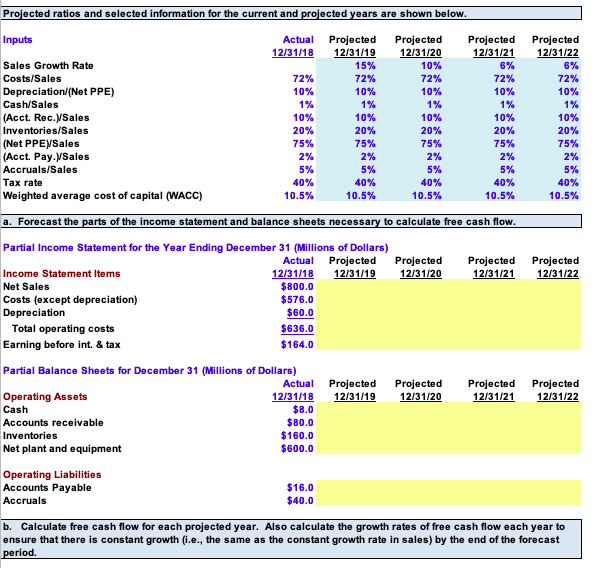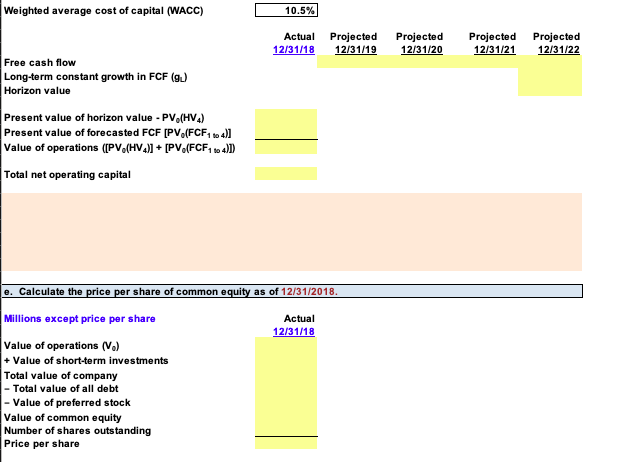



Start with the partial model in the file Ch09 P11 Build a Model.xlsx on the textbook's Web site, which contains Henley Corporation's most recent financial statements. Use the following ratios and other selected information for the current and projected years to answer the next questions Income Statement for the Year Ending December 31 (Millions of Dollars) 2018 $ Net Sales 800.0 Costs (except depreciation) 576.0 Depreciation 60.0 Total operating costs Earning before int. & tax 636.0 164.0 Less interest 32.0 Earning before taxes Taxes (40%) 132.0 52.8 Net income before pref. div. Preferred div. 79.2 1.4 Net income avail, for com, div. 77.9 Common dividends Addition to retained earnings 31.1 46.7 Number of shares (in millions) Dividends per share 10 $ 3.11 Balance Sheets for December 31 (Millions of Dollars) Liabilities and Equity Accounts Payable Notes payable 2018 Assets 2018 Cash 8.0 16.0 20.0 Short-term investments 40.0 Accounts receivable 80.0 Accruals 40.0 Inventories 160.0 Total current liabilities 96.0 Long-term bonds Preferred stock Total current assets 268.0 300.0 Net plant and equipment Total Assets 600.0 15.0 (Par plus PIC) 868.0 257.0 Retained earnings 200.0 Common equity $ 457.0 Total liabilities and equity $ 868.0 Projected ratios and selected information for the current and projected years are shown below. Inputs Actual Projected Projected 12/31/20 10% Projected Projected 12/31/18 12/31/19 15% 12/31/21 12/31/22 Sales Growth Rate 6% 6% Costs/Sales 72% 72% 72% 72% 72% Depreciation/(Net PPE) 10% 10% 10% 10% 1% 10% 1% 1% 1% 1% Cash/Sales 10% 10% 10% 10% (Acct. Rec.Sales Inventories/Sales 10% 20% 20% 20% 20% 75% 20% 75% 75% (Net PPEySales (Acct. Pay.VSales 75% 75% 2% 2% 2% 2% 2% 5% 5% 5% Accruals/Sales 5% 5% Tax rate 40% 40% 40% 40% 40% Weighted average cost of capital (WACC) 10.5% 10.5% 10.5% 10.5% 10.5% a. Forecast the parts of the income statement and balance sheets necessary to calculate free cash flow Partial Income Statement for the Year Ending December 31 (Millions of Dollars) Projected 12/31/19 Actual Projected 12/31/22 Projected 12/31/20 Projected 12/31/21 12/31/18 Income Statement Items $800.0 Net Sales Costs (except de preciation) Depreciation $576.0 $60.0 Total operating costs $636,0 $164.0 Earning before int. & tax Partial Balance Sheets for December 31 (Millions of Dollars) Actual Projected 12/31/19 Projected 12/31/20 Projected 12/31/21 Projected 12/31/22 Operating Assets 12/31/18 $8.0 Cash $80.0 Accounts receivable $160.0 $600.0 Inventories Net plant and equipment Operating Liabilities Accounts Payable $16.0 $40.0 Accruals b. Calculate free cash flow for each projected year. Also calculate the growth rates of free cash flow each year to ensure that there is constant growth (i.e., the same as the constant growth rate in sales) by the end of the forecast period. Actual Projected Projected 12/31/20 Projected 12/31/21 Projected 12/31/22 Calculation of FCF 12/31/18 12/31/19 Operating current assets Operating current liabilities Net operating working capital Net PPE Total net operating capital NOPAT Investment in total net operating capital Free cash flow na na Growth in FCF na na Growth in sales c. Calculate the return on invested capital (ROIC-NOPATITotal net operating capital) and the growth rate in free cash flow. What is the ROIC in the last year of the forecast? What is the long-term constant growth rate in free cash flow (g is the growth rate in FCF in the last forecast period because all ratios are constant)? Do you think that Hensley's value would increase if it could add growth without reducing its ROIC? (Hint: Growth will add value if the ROIC> WACC/[1+WACC. Do you think that the company will have a value of operations greater than its total net operating capital? (Hint: Is ROIC WACC/1+g?) Projected Actual Projected 12/31/19 Projected Projected 12/31/22 12/31/21 12/31/18 12/31/20 Return on invested capital (ROIC NOPAT/Total net operating capital]) Weighted average cost of capital (WACC) Long-term cons tant growth in FCF (gu WACCI(1+g WACC/(1+WACC) 10.5% 10.5% 10.5% 10.5% 10.5% na na na na na na na na na d. Calculate the current value of operations as of 12/31/2018. (Hint: First calculate the horizon value at the end of the forecast period, which is equal to the value of operations at the end of the forecast period. Assume that the annual growth rate beyond the horizon is equal to the growth rate in FCF at the horizon.) How does the current value of |operations compare with the current amount of total net operating capital? Weighted average cost of capital (WACC) 10.5% Actual Projected 12/31/19 Projected 12/31/20 Projected Projected 12/31/22 12/31/18 12/31/21 Free cash flow Long-term constant growth in FCF (g Horizon value Present value of horizon value PV(HV4) Present value of forecasted FCF [PV (FCF, 04) Value of operations (PVo(HVA) [PV (FCF, to 4)) Total net operating capital e. Calculate the price per share of com mmon equity as of 12/31/2018 Millions except price per share Actual 12/31/18 Value of operations (Va) Value of short-term investments Total value of company Total value of all debt - Value of preferred stock Value of common equity Number of shares outstanding Price per share Start with the partial model in the file Ch09 P11 Build a Model.xlsx on the textbook's Web site, which contains Henley Corporation's most recent financial statements. Use the following ratios and other selected information for the current and projected years to answer the next questions Income Statement for the Year Ending December 31 (Millions of Dollars) 2018 $ Net Sales 800.0 Costs (except depreciation) 576.0 Depreciation 60.0 Total operating costs Earning before int. & tax 636.0 164.0 Less interest 32.0 Earning before taxes Taxes (40%) 132.0 52.8 Net income before pref. div. Preferred div. 79.2 1.4 Net income avail, for com, div. 77.9 Common dividends Addition to retained earnings 31.1 46.7 Number of shares (in millions) Dividends per share 10 $ 3.11 Balance Sheets for December 31 (Millions of Dollars) Liabilities and Equity Accounts Payable Notes payable 2018 Assets 2018 Cash 8.0 16.0 20.0 Short-term investments 40.0 Accounts receivable 80.0 Accruals 40.0 Inventories 160.0 Total current liabilities 96.0 Long-term bonds Preferred stock Total current assets 268.0 300.0 Net plant and equipment Total Assets 600.0 15.0 (Par plus PIC) 868.0 257.0 Retained earnings 200.0 Common equity $ 457.0 Total liabilities and equity $ 868.0 Projected ratios and selected information for the current and projected years are shown below. Inputs Actual Projected Projected 12/31/20 10% Projected Projected 12/31/18 12/31/19 15% 12/31/21 12/31/22 Sales Growth Rate 6% 6% Costs/Sales 72% 72% 72% 72% 72% Depreciation/(Net PPE) 10% 10% 10% 10% 1% 10% 1% 1% 1% 1% Cash/Sales 10% 10% 10% 10% (Acct. Rec.Sales Inventories/Sales 10% 20% 20% 20% 20% 75% 20% 75% 75% (Net PPEySales (Acct. Pay.VSales 75% 75% 2% 2% 2% 2% 2% 5% 5% 5% Accruals/Sales 5% 5% Tax rate 40% 40% 40% 40% 40% Weighted average cost of capital (WACC) 10.5% 10.5% 10.5% 10.5% 10.5% a. Forecast the parts of the income statement and balance sheets necessary to calculate free cash flow Partial Income Statement for the Year Ending December 31 (Millions of Dollars) Projected 12/31/19 Actual Projected 12/31/22 Projected 12/31/20 Projected 12/31/21 12/31/18 Income Statement Items $800.0 Net Sales Costs (except de preciation) Depreciation $576.0 $60.0 Total operating costs $636,0 $164.0 Earning before int. & tax Partial Balance Sheets for December 31 (Millions of Dollars) Actual Projected 12/31/19 Projected 12/31/20 Projected 12/31/21 Projected 12/31/22 Operating Assets 12/31/18 $8.0 Cash $80.0 Accounts receivable $160.0 $600.0 Inventories Net plant and equipment Operating Liabilities Accounts Payable $16.0 $40.0 Accruals b. Calculate free cash flow for each projected year. Also calculate the growth rates of free cash flow each year to ensure that there is constant growth (i.e., the same as the constant growth rate in sales) by the end of the forecast period. Actual Projected Projected 12/31/20 Projected 12/31/21 Projected 12/31/22 Calculation of FCF 12/31/18 12/31/19 Operating current assets Operating current liabilities Net operating working capital Net PPE Total net operating capital NOPAT Investment in total net operating capital Free cash flow na na Growth in FCF na na Growth in sales c. Calculate the return on invested capital (ROIC-NOPATITotal net operating capital) and the growth rate in free cash flow. What is the ROIC in the last year of the forecast? What is the long-term constant growth rate in free cash flow (g is the growth rate in FCF in the last forecast period because all ratios are constant)? Do you think that Hensley's value would increase if it could add growth without reducing its ROIC? (Hint: Growth will add value if the ROIC> WACC/[1+WACC. Do you think that the company will have a value of operations greater than its total net operating capital? (Hint: Is ROIC WACC/1+g?) Projected Actual Projected 12/31/19 Projected Projected 12/31/22 12/31/21 12/31/18 12/31/20 Return on invested capital (ROIC NOPAT/Total net operating capital]) Weighted average cost of capital (WACC) Long-term cons tant growth in FCF (gu WACCI(1+g WACC/(1+WACC) 10.5% 10.5% 10.5% 10.5% 10.5% na na na na na na na na na d. Calculate the current value of operations as of 12/31/2018. (Hint: First calculate the horizon value at the end of the forecast period, which is equal to the value of operations at the end of the forecast period. Assume that the annual growth rate beyond the horizon is equal to the growth rate in FCF at the horizon.) How does the current value of |operations compare with the current amount of total net operating capital? Weighted average cost of capital (WACC) 10.5% Actual Projected 12/31/19 Projected 12/31/20 Projected Projected 12/31/22 12/31/18 12/31/21 Free cash flow Long-term constant growth in FCF (g Horizon value Present value of horizon value PV(HV4) Present value of forecasted FCF [PV (FCF, 04) Value of operations (PVo(HVA) [PV (FCF, to 4)) Total net operating capital e. Calculate the price per share of com mmon equity as of 12/31/2018 Millions except price per share Actual 12/31/18 Value of operations (Va) Value of short-term investments Total value of company Total value of all debt - Value of preferred stock Value of common equity Number of shares outstanding Price per share










